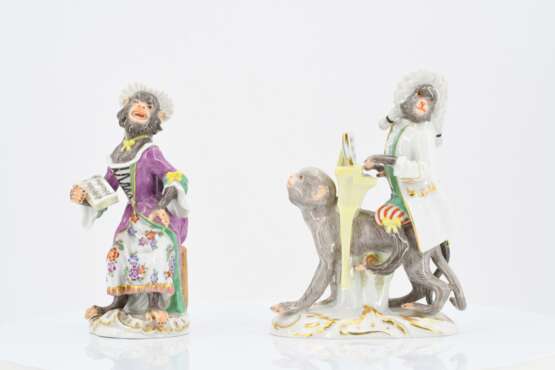ID 841941
Lot 1 | 14 Figurines from the ape Chapel
Estimate value
€ 6 000 – 8 000
Meissen.
Date: 20th century.
Maker/Designer: Model J. J. Kaendler.
Technique: Porcelain, enriched in colors and gold.
Description: Consisting of: Flute player, 2 singers, drum carrier, triangle player, violinist, bagpipe
player, conductor, harpist, horn player, hurdy-gurdy player, monkey with drumsticks,
monkey riding with piano, drummer with flute.
Measurement: Height 12,5 - 18,5cm.
Mark: Swordsmark, once with 4 grinding marks, twice with 2 grinding marks, 3/11/15/19/20/60001/60006/60008/60009/60012-60015/60018.
Provenance:
Private collection cologne.
Literature:
- Adams, Len and Yvonne: Meissen Portrait Figures, Leicester 1992, P.188 und 195.
- Rückert, Rainer: Meissener Porzellan von 1710-1810. Cat. Nr.1064-1078
- www.meissen.com (Stand 04.03.2020)
The monkey figurines, dressed in elaborate rococo clothing, parody the upper social class of the 18th century and its allures in a highly exaggerated manner. Historical records suggest that the eccentric apes were inspired in particular by the chapel of Count Brühl. The male monkeys take on the roles of the musicians, while the female monkeys are portrayed as singers.
Even though the exact date of origin of the chapel is not precisely documented, the form numbers and a purchase of 19 such figures by Madame de Pompadour suggest that the figurines were developed around 1753. Probably created by Johann Joachim Kaendler and reviewed in 1765/66 with the assistance of Peter Reinicke, the monkeys are considered the "most bizarre classic of the Meissen Baroque" (www.meissen.com).
In the middle of the 18th century depictions of monkeys, which in a parodistic way depict human traits, enjoyed great popularity. This genre of the so-called "Singerie" (French "singe" = monkey) was not only interpreted in porcelain, but can also be found in wall and ceiling frescoes or on goblins. There is a presumption that Christophe Hueet's wall paintings in the so-called monkey cabinet of Chantilly Castle may be regarded as a model for the Meissen chapel. Another French model could be a monkey chapel of the Mennecy Manufactory from the 1740s. Another example of a chapel that resembles Kaendler's models for the Meissen manufactory is an alabaster chapel from Venice, made around 1745, that today is exhibited at the Metropolitan Museum in New York.
| Manufactur: | Meissen Porcelain Factory |
|---|---|
| Auction house category: | Porcelain |
| Manufactur: | Meissen Porcelain Factory |
|---|---|
| Auction house category: | Porcelain |
| Address of auction |
VAN HAM Kunstauktionen GmbH Hitzelerstr. 2 50968 Köln Germany | ||||||||||||||
|---|---|---|---|---|---|---|---|---|---|---|---|---|---|---|---|
| Preview |
| ||||||||||||||
| Phone | +49 221 92586215 | ||||||||||||||
| Fax | +49 221 92 58 62 4 | ||||||||||||||
| Buyer Premium | 32% | ||||||||||||||
| Conditions of purchase | Conditions of purchase | ||||||||||||||
| Business hours | Business hours
|




























